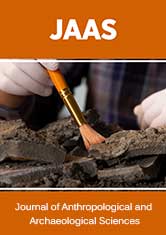
Lupine Publishers Group
Lupine Publishers
Menu
ISSN: 2690-5752
Review Article(ISSN: 2690-5752) 
The Original Meaning of Tityus and Prometheus Volume 10 - Issue 1
Felice Vinci*
Senior Research Fellow of ATINER, Italy
Received: October 18, 2024; Published: October 23, 2024
Corresponding author: Felice Vinci, Senior Research Fellow of ATINER, Italy
DOI: 10.32474/JAAS.2024.10.000330
Abstract
Starting from a previous article in which we developed the hypothesis that the Elysian Fields were located on the island of Hawaii in Polynesia, the examination of the two passages in which Homer mentions the giant Tityus (whom he connects to Rhadamanthus, the lord of the Elysian Fields), as well as the comparison of his figure with that of Prometheus—a god of fire with whom Tityus shares the same torment—make plausible the hypothesis that these two mythical giants, both called “sons of the Earth”, were born as metaphors of shield volcanoes, of which the Hawaiian ones are the most famous examples. Also striking is their affinity with Ti’iti’i, a Polynesian god of fire who, after a battle with the god of earthquakes, brings fire to the people of Samoa. So, on the one hand he can be compared to Prometheus, and on the other his name is similar to that of Tityus (and also to that of Thiazi, who in Norse mythology commits a crime similar to the one for which Tityus is punished). It follows that at the origin of Tityus, Prometheus and Ti’iti’i—and perhaps also of the Titans—there could have been some mythical entity inspired by that particular type of volcanoes, which by different ways has reached us from a remote prehistory and, therefore, should be added to the correspondences that have previously emerged between the Greek and Polynesian worlds. Not only that: this has led to a deeper study of the singular homonymy between a Polynesian volcanic island called Pohnpei (where the imposing megalithic remains of the ancient city of Nan Madol are located) and Pompeii (the city destroyed by a volcanic eruption in 79 AD, whose name has a still controversial etymology). Several clues have emerged that this homonymy is not at all due to chance, which confirms the plausibility of the hypothesis that there was a common prehistoric civilization, spread everywhere on Earth through navigation, which, according to recent studies, had a notable development during the megalithic era.
Keywords: Tityus, Prometheus; Thiazi; Titans; Ti’iti’I; shield volcanoes; Haleakala; Hekla; Pohnpei; Pompeii; Nan Madol
Introduction
In this article, which builds on the conclusions of a previous article [1] in which a new hypothesis has been proposed on the real location of the Elysian Fields, we will try to demonstrate that some characters of Greek mythology, such as Tityus and Prometheus, could have been originally inspired by erupting volcanoes, and to this end we have used a methodology that consists in a new critical examination of not only classical sources but also other literary contexts, which places due emphasis on some aspects to which sector studies had not yet paid the right attention.
First of all, it is worth briefly summarizing some salient aspects of the aforementioned article. In the Polynesian world there is no lack of clues that seem to attest to ancient contacts with Caucasian populations, such as the presence of megaliths and the physical appearance of many of the natives encountered by the first European explorers [2], not to mention myths, legends, customs, characteristics and names of deities, even traditional tales that curiously recall both the Iliad and the Odyssey. The correspondence between the name of the traditional Polynesian dance, the hula (also called hura, given the oscillation between L and R that is found in the local dialects), and the Greek term choros, “dance” is also striking (in particular, the typical dance of Tahiti is called Hori Tahiti). Equally astonishing is the case of the traditional Polynesian songs, the mele, a name identical to the Greek melos, “song, epic song”, in all its shades of meaning.
In this picture, which seems to outline a prehistoric maritime civilization spread across the Earth, certain peculiar characteristics that Greek poets attribute to the Elysian Fields (including, but not limited to, the extraordinary mildness of the climate, and in particular a very pleasant refreshing wind) seem to be typical of the island of Hawaii—where especially the area surrounding the beautiful Hilo Bay shows astonishing convergences between Greek and Polynesian mythology—to the point of suggesting the location of these mythical places right there, “at the bounds of the world”, where, according to Homer, Hesiod and Pindar, Cronos reigned, flanked by the “blond Rhadamanthus”, after being dethroned by Zeus. In fact, according to Pindar, here “golden flowers shine from beautiful trees (…) for those who entwine their hands with wreaths and garlands according to the righteous counsels of Rhadamanthus” [3]. This is a delightfully “Hawaiian” image, where those “golden flowers” that bloom on the trees allude to Hawaiian hibiscus, a shrub that produces a beautiful golden flower that has been the official state flower of Hawaii since 1988.
As for the many other examples that can be given to support this, we refer to the article cited above, where we also dwelt on the astonishing relations between the Polynesian world and that of the Phaeacians, the mythical navigators of the Odyssey. What is most striking are the extraordinary correspondences between the typical Polynesian monuments, the marae—the sacred places, with a rectangular platform paved in stone and a perimeter marked by high stones, while in the center or on one side there is an upright stone, also considered sacred, in an open space facing the sea, where before the arrival of the Europeans the religious, political and social rituals of the ancient Polynesians took place—and the very particular structure where according to Homer the Phaeacians, called “nausiklytoi” (famed for their ships), gathered in assembly: “ There is their place of assembly about the fair altar of Poseidon, fitted with huge stones set deep in the earth” [4].
What also appears very significant is the fact that these correspondences are not limited to the structures, but are also found in their use. In fact, during the assembly (which took place precisely on the seashore) in which the Phaeacians welcomed Odysseus, considered a guest of honour, the Odyssey tells that a dance of young people took place accompanied by the singing of a bard with the lyre [5]. This corresponds to the fact that even today the Polynesians perform their dances during the welcoming ceremony for guests that takes place in the marae, also characterized by refined speeches and traditional songs, exactly as the Homeric Phaeacians did.
In that article we also noted that Ino, the sea goddess who saves Odysseus from a storm and miraculously allows him to land in the land of the Phaeacians, has many traits in common with Hina, the great Polynesian goddess linked to the sea and the moon: even the name attributed by Homer to Ino, “Leucothea”, that is, “the white goddess”, corresponds to the fact that in the Polynesian language hina-hina means “white” [6].
From all this it is reasonable to deduce that the mythical Phaeacians, the “famous navigators” of the Odyssey, could be the last memory of a seafaring civilization, preceding the world of the Trojan War, which had extended over a good part of the planet’s oceans thanks to the Holocene Climatic Optimum (HCO), also called the Atlantic Climatic Optimum [7], which ensured an exceptionally mild climate in many parts of the world for thousands of years precisely in conjunction with the flourishing of the megalithic civilization. This is corroborated by the fact that in a recent article on European megalithism Bettina Schulz Paulsson argues for “advanced maritime technology and seafaring in the megalithic age (…) The maritime skills, knowledge, and technology of these societies must have been much more developed than hitherto presumed” [8].
Furthermore, at that time, thanks to temperatures much higher than today, it was possible to easily reach the Pacific from the Atlantic Ocean, passing through the Arctic Ocean, navigable in the summer, where ships followed the entire northern coast of Canada up to the Bering Strait, from where the north-east trade winds then pushed them towards the island of Hawaii (i.e. the Elysian Fields, of which Homer recalls the typical fresh wind [9] of Hawaii). This avoided them having to round the very distant and treacherous Cape Horn—considered a real “ship graveyard” due to the impetuous winds, the currents, the icebergs, the rocky shallows and so on—as the Europeans (Spanish, French, English and so on) were instead forced to do when, centuries before the industrial revolution, with their sailing ships they managed to extend their empires as far as the archipelagos of Polynesia.
As to the plausibility of transoceanic voyages during prehistory, we have specifically dealt with this question in a previous article [10] aimed at identifying the real location of the mythical Pillars of Hercules, in which we verified that in the works of Plutarch and Plato there are correct references to the geography of the continent beyond the Atlantic and to the islands located along the route to reach it. In particular, Plutarch mentions a great continent surrounding the Atlantic Ocean and the islands that lie on that route, and then focuses on an ancient settlement of Greeks, called “the Continentals” [11], in the Canadian region of the Gulf of St. Lawrence, of which he indicates the latitude with astonishing precision. Likewise, Plato, in addition to announcing with great emphasis the existence of a continent beyond the Atlantic—about which he claims that in a previous era “it was navigable” [12]— mentions the islands along the route to get there.
On the other hand, the memory of ancient European settlements on the American side of the North Atlantic (perhaps also linked to the extraction of copper from the ancient mines of Isle Royale, the largest island in Lake Superior) seems to emerge from various clues, such as the persistence of myths and legends comparable to those of the Old World, as well as the Caucasian traits of some Native Americans, which seem to corroborate the idea of ancient contacts between the two opposite sides of the Atlantic.
All this can immediately explain the extraordinary convergences found between myths, legends, folklore and megalithic constructions spread throughout the planet. But now, given these premises, the time has come to get to the heart of this article.
Tityus, the Giant “Son of the Earth”
Let us now examine a passage from the Odyssey in which “fairhaired Rhadamanthus”—that is, the ancient lord of the Elysian Fields according to Homer [13] and Pindar [14]—is put in direct relation with the Phaeacian world. Here Alcinous, the king of the Phaeacians, promises Odysseus that a Phaeacian ship will take him home, “even if it were far beyond Euboea, about which those of our people who saw it, when they accompanied fair-haired Rhadamanthus to see Tityus, the son of Gaea, say that it is the furthest of lands; thither they went and without toil accomplished their journey, and on the selfsame day they came back home” [15].
As for Tityus (Tityos in Greek), in this passage Homer claims that he was “son of Gaea”, that is, the Earth, and in the only other occasion in which he mentions him he shows him in Hades: “And I saw Tityus, the glorious son of Gaea, stretched out on the ground over nine plethra; and two vultures sat, one on either side, and tore his liver, penetrating his entrails; nor could he defend himself with his hands, because he dared to rape Leto, wife of Zeus, who was going to Pytho passing through Panopeus with its lovely lawns” [16].
Now, given that in ancient Greece the plethron was a unit of length equal to about 30 meters, and therefore “nine plethra” here seems to indicate nothing other than an excessive, disproportionate size, it is spontaneous to ask who, or what, this gigantic being— who was even larger than Ares (who stretched out on the ground “more than seven plethra”) [17]—actually was. Here we must immediately exclude that the poet is referring to a human being, as also confirmed by the fact that the Phaeacians took Rhadamanthus “to see” (epopsómenon) that strange being, certainly not to talk to him.
At this point, to understand what we are dealing with, it seems reasonable to suppose that this episode can be read in terms of an ancient poetic metaphor, whose original meaning has been lost over the centuries. But what kind of metaphor? Considering on the one hand the Hawaiian setting of the world of Rhadamanthus, and on the other the fact that the torment of Tityus is identical to that of Prometheus, that is, a god of fire (to whom we will return shortly), one can hypothesize that behind the image of the giant Tityus, this “son of the Earth” that Rhadamanthus goes to see on board a ship, probably hides one of the great Polynesian volcanoes.
Indeed, according to the website of the Hawaii Volcanoes National Park, these volcanoes—and in particular those of the Island of Hawaii, where we located the Elysian Fields—are called “shield volcanoes” because they produce lava flows that, once solidified, “form gently sloping, shield-like mountains” [18] with a particular convex shape, that really do resemble the lobes of the liver (even in color). As the eruptions follow one another, lava cools and solidifies forming new “lobes” which overlap the previous ones and will then be covered by other layers of lava in subsequent eruptions. Incidentally, the fact that the website just mentioned defines the largest volcano on the island of Hawaii as “a sleeping giant” fits well with this picture.
We would like to emphasize again that this identification is also supported by the fact that Homer, in both of his citations of Tityus, always calls him “son of Gaea”, that is, of the Earth (which is natural for a volcano), and his eternal torment in Hades seems at this point to evoke the memory of the convulsions and spasms of the great giant lying down, as an extraordinary metaphor for the seismic shocksand roars connected to volcanic eruptions. One also might suppose that in one of them an ancient city was destroyed, the last memory of which, obscured by the millennia that have passed, could have come down to us under the metaphor of the violence done to Leto, Apollo’s mother. She was perhaps the goddess protector of that city, who failed to protect it from the fire produced by a “son of the Earth”.
On the other hand, it is with a similar type of metaphor that one might read the story of Thiazi—not by chance defined as “a terrible giant” in the Nordic Edda [19]—who in the guise of an eagle kidnapped the goddess Idhunn and subsequently died in the flames. Here the singular correspondence between the name of Tityus and that of Thiazi is striking, which is also perfectly consistent with the blond hair of Rhadamanthus and his Nordic name (which corresponds to the Icelandic term ráðamanður, “leader”, “eminent person”, and to the Danish rådmand, “adviser”). As for Tityus-Thiazi, it could be linked to the Latin words titio (“burning ember”), and attitiare (“to rekindle” the fire, from which words such as the Italian “attizzare”, the French “attiser” and the Spanish “atizar” derive).
Not only that: we could perhaps associate this same root with the name of the mythical Titans, also children of Gaea, since Homer, on the only occasion in which he mentions them, emphasizes their subterranean dimension: “Those who are under Tartarus, called the Titans” [20]. The Titans—perhaps comparable to the angels fallen from Heaven in the Judeo-Christian tradition—bring to mind the volcanoes of Iceland and those of the Ring of Fire in the Pacific Ocean. The latter were probably well known to the navigators of the megalithic era, who, taking advantage of the navigability of the Arctic Ocean during the Holocene Climatic Optimum, sailed between the North Atlantic (called the Sea of Cronos by the Greeks) and the archipelagos of the Pacific Ocean, leaving traces of their presence everywhere, such as megaliths, myths and folklore that are found, often similar to each other, scattered throughout the world.
Their last memory is found in the myth of Atlantis, handed down by Plato, according to whom this prehistoric world civilization was born and developed on a large island in the North Atlantic, also mentioned in the Indian Mahabharata with the name of “White Island (...) an island of great splendor on the northern shores of the Ocean of Milk (...) The men who inhabit it have a complexion as white as the rays of the moon” [21]. In our opinion there are many good reasons to identify it with Greenland [22], taking into account the fact that in the megalithic age the Climatic Optimum ensured much better living conditions than today, even at very high latitudes [23].
Tityus, Prometheus and a Polynesian god of fire
In a Samoan legend we find the mythological figure of Ti’iti’i (or also Tiki; in Samoan legends, he appears in tales very similar to those concerning the demigod Maui, found in other island cultures). This character, who is almost homonymous with the Homeric Tityus, manages to bring fire to the population of Samoa after a battle with the god of the earthquake [24].
In short, Ti’iti’i is a god of fire who on the one hand has almost the same name as Tityus and, on the other, brings us back to Prometheus. In turn, Prometheus (whom Homer never mentions) on the one hand steals fire from the gods and brings it to men as Ti’iti’i does, and on the other hand is condemned to a torment identical to that of Tityus in the Odyssey. Indeed, in a tragedy by Aeschylus, the god Hermes announces to Prometheus that “A fleshhungry eagle will mercilessly tear off a large piece of your body; an uninvited guest who will feast all day, devouring your liver, the black and bloody delicacy of the feast” [25].
As for that eagle, Hyginus, a Roman writer, calls it a “fiery eagle” [26]. This image of the “fiery eagle” swooping down from above could well refer to an erupting volcano, which is able to send up splashes of lava (up to over 100 meters high) which then fall down, like a bird of prey, onto the previous lava that has already solidified, amid fearful roars and terrifying seismic shocks. On the other hand, Thiazi, the terrible Norse giant whose name is comparable to that of Tityus and Ti’iti’i, kidnaps Idhunn by taking on the features of an eagle.
And it is again Aeschylus’ Prometheus that suggests another analogy with Tityus, when he declares that his mother is “Themis, or Gaia [the Earth], a single person with many names” [27]. As for Prometheus’ relationship to volcanic activity, some have placed the story of Prometheus on Mount Caucasus or Mount Kazbek [28], two volcanic peaks in the Caucasus Mountains. However, so far only astronomers have thought of giving Prometheus the features of a volcano, when they gave his name to an active volcano located on Io [29], one of Jupiter’s satellites (thus Aeschylus, strictly speaking, would not have called it “a son of the Earth”!).
Prometheus’ strong bond with fire—so close that in Greek mythology he was considered a god of fire [30]—is also attested by Pausanias: “In the Academy there is an altar of Prometheus, which is the starting point of a race that is done holding lighted torches in one’s hand” [31]. Furthermore, Prometheus’ close relationship with fire (pŷr in Greek) could suggest the hypothesis, which in our opinion deserves further investigation, that even the root of his name, the meaning of which is still unknown, could be linked to fire. In this regard, we recall the controversial hypothesis of Georges Dumézil, who has linked the name of the Roman priest called flamen to the Vedic brahmán [32]: the flamen, therefore, would be the priest “who lights the fire” on the sacrificial altar [33]. This hypothesis was contested by many scholars, but Andrew Sihler considers the claim that flamen might be a cognate of the Sanskrit term to be plausible [34].
In short, also considering that the Vedic myth of the theft of fire by Mātariśvan is similar to the Greek one [35], we suspect that the name Prometheus could literally mean “fire-god”, as can be deduced by comparing the prefix prome- to the root of flamenbrahmán, which in turn corresponds to the Latin flamma, “flame” [36]. Furthermore, in our opinion even the controversial etymology of the name of the Pleiades could be traced back to the same root, considering that sometimes they are closely linked to fire. In particular, it is precisely in Indian mythology that the Pleiades are called “the stars of fire” and their ruling deity is Agni, the Vedic god of fire [37]. Moreover, according to a legend of the Wurundjeri people of south-eastern Australia, they are the fire of seven sisters, who were the first to know fire-making; each of them carried live coals on the end of their digging sticks, which later became the bright stars of the Pleiades cluster [38]. Furthermore, the passage in the Book of Enoch mentioning “seven stars of heaven bound together (…) burning with fire” [39] probably refers to the Pleiades.
One should also note that Greek mythology specifically mentions the relationship between Prometheus and Tityus, his Homeric counterpart: “One sees in Panopeus, on the road, a small brick building, and in this building a statue of Pentelic marble; some say it is Aesculapius, others that it is Prometheus (…) These stones are a residue of the silt with which Prometheus created the human race. The tomb of Tityus is also depicted on the edge of the ravine” [40]. Incidentally, the only passage in the Odyssey in which the city of Panopeus is mentioned is precisely the one, cited above, referring to Tityus, who “dared to rape Leto, wife of Zeus, who was going to Pytho passing through Panopeus” [41].
Furthermore, even the fact that Prometheus is credited with creating the human race from silt has a precise correspondence in the figure of Ti’iti’i (or Tiki): in fact “Tiki is said to have made man by mixing his blood with clay (…) In Tahiti, it is said that Tii (Tiki) was the first man, and was made from red earth. The first woman was Ivi (in Samoa and Rotuma the first woman was called Iva), and she was made from one of the bones (“ivi”) of Tii, the first man” [42]. Here one can also note that the name of Ivi-Iva is almost identical to that of the biblical Eve, created from one of the ribs of Adam. Another convergence is that of the Hawaiian term kahuna, originally referring to a spiritual master, which seems to be comparable to the Hebrew kohen, also considering that the memories of the Flood and the Tower of Babel are found in Polynesian myths [43], not to mention the amazing correspondence between Rongo, the god of agriculture of the Maori of New Zealand, and an ancient agricultural deity of Karelia, in the far north of Europe, whose name is “Rongotheus, who supplied the rye” [44]. And what about the extraordinary similarity, noted and reported by Guillaume de Hevesy, between the “rongorongo” characters of the inscriptions discovered in the 19th century on Easter Island and those, dating back to the 3rd millennium BC, of the Indus Valley civilization [45]? And yet they are 20,000 km apart, exactly at the antipodes! On the other hand, also the fact that the Pleiades in all the mythologies of the world are always seven—although the number of Pleiades visible in the night sky varies between six and twelve, depending on the visibility at the time and the visual acuity of the observer— seems to suggest a sort of prehistoric globalization.
However, here we would like to underline again the astonishing triangle Prometheus-Tityus-Ti’iti’i, in which Prometheus corresponds to the Homeric Tityus, Tityus has almost the same name as Ti’iti’i, and Ti’iti’i in turn corresponds to Prometheus. We are dealing with the same mythical entity, inspired by that particular type of volcanoes, which by different way has come to us from a remote prehistory and, therefore, must be added to all the correspondences previously examined between the Greek and Polynesian worlds.
At this point we note that on the southern coast of the island of Maui, adjacent to Hawaii, there is a large active volcano, Haleakala, more than 3000 meters high. Since Maui is also the name of the demigod of whom Ti’iti’i is the Samoan alter ego, one might suspect that the erupting volcano that Rhadamanthus went to see with the Phaeacians was this one. Indeed, this could perhaps explain the absurdity of that return trip, lasting only one day, of the Phaeacian ship after accompanying Rhadamanthus to see Tityus. In short, it seems reasonable to suppose that, due to the vicissitudes of a very long oral tradition to which were later added the difficulties of putting it in writing, the round trip from Hilo Bay to the adjacent island of Maui, lasting only one day, over time would instead have been interpreted as the time taken by the Phaeacian ship to return home from that island “at the bounds of the world”, probably also thanks to the fame of very good navigators that the Odyssey attributed to the Phaeacians (who, at the time when the oral sagas from which the Homeric poems originated were put into writing, had probably become as mythical as they are for us today).
Now we must try to clarify what Alcinous is referring to when he mentions Euboea, “of which those of my men who have seen it, when they accompanied the fair-haired Rhadamanthus to see Tityus, son of Gaia, say that it is the farthest”. We must, of course, exclude the Euboea that we know well: in fact it makes no sense to define it as “the farthest”, while it is located in a central position in its basin. Instead, we can ask whether that strange Euboea where Rhadamanthus lived, which according to our location of the Elysian Fields should correspond to the island of Hawaii, could have taken its name from that of some island located in the far north, where the ancestors of the Achaeans presumably lived before the climatic collapse that marked the end of the prehistoric Climatic Optimum forced them to move south (we will return to this last point shortly).
Indeed, in the Arctic Ocean, not far from the North Cape, is the Norwegian island of Havøya (called Ávvá by the Sami). It is reasonable to suppose that this name was at the origin not only of the name of Euboea (whose modern name, Evia, seems to evoke Havøya-Ávvá), but also of the name of the island of Hawaii where, during the megalithic age, Cronos and Rhadamanthus reigned. Incidentally, still on the name of Euboea, one could argue that it means “good for oxen” (eu-bous in Greek), while it could instead be an ancient misunderstanding about its original name (due to the fact that the Homeric Achaeans lived in a period much later than the megalithic age) This is confirmed by the fact that the name of its inhabitants, the Homeric Abantes, who took part in the Trojan War, does not correspond to Euboea but instead recalls that of its original root, which we also find in the name of the current Evia and in that of Havøya-Ávvá, which in turn is found in the name of the island of Hawaii and also in that of the Aviones, that is, the ancient inhabitants of Öland, the Swedish island which is the Baltic counterpart of the Greek Euboea [46].
All this corroborates the identification of Euboea—the one cited by Alcinous in relation to Rhadamanthus—with the island of Hawaii, whose name was probably modeled on that of the Arctic island of Havøya-Ávvá, which, thanks to the Holocene Climatic Optimum, enjoyed a much milder climate during the megalithic period than it does today.
As for this last point, we note that there are several indications in the Odyssey [46] that the ancestors of the Achaeans lived in northern Scandinavia during the Climatic Optimum. The memory of its dramatic end, which also marked the end of the megalithic era, has been handed down to us by the Avesta, the sacred Iranian text of Zoroastrianism, which tells of the destruction of the primordial Indo-European paradise (the “Airyana Vaêjo”) by snow and frost: the god Ahura Mazda warned Yima, the first king of men, that a series of very harsh winters was about to destroy his country and that subsequently there would be ten months of winter and only two of summer [47], which is the current climate of the Arctic regions.
In turn, Greek mythology recalls this event under the metaphor of Cronos, the lord of the golden age, who was overthrown by Zeus, the storm god, and his two brothers, Poseidon, lord of the stormy sea, and Hades”[48]. In fact, the “rotten home” [49] of the latter (the lord of the dead, that is, of the ancestors of the Homeric Achaeans) appears in the adventures of Odysseus in a desolate Arctic context, located almost at the northern tip of the Scandinavian peninsula [46], which became uninhabitable after the climatic collapse that marked the end of the prehistoric Climatic Optimum.
In short, it can be assumed that this climatic catastrophe forced the ancestors of the Homeric Achaeans to move from northern Scandinavia to the Baltic area, where the Trojan War took place [50], from where later, after the Trojan War, some of their descendants moved to the Mediterranean, where they gave rise to the Mycenaean civilization. In the meantime, other peoples, also probably coming from the far north, fled to the Russian steppes and Southern Urals—where the Sintashta culture flourished, widely regarded as the origin of the Indo-Iranian languages [51]—from where their descendants later reached India and Iran. This explains why “There are many similarities between Sintasthta/Androvono rituals and those described in the Rig Veda and such similarities even extend as far as to the Nordic Bronze Age” [52] and, on the other hand, the Nordic Bronze Age maintained close trade links with Mycenaean Greece, with whom it shares several “striking similarities” [53].
But this is an incomplete picture: many pieces of the puzzle are still missing, which future studies will have to find and put in their place. In the meantime, we believe that what has been said so far has made plausible the hypothesis that certain mythical tales and characters related to fire originated from natural phenomena such as volcanic eruptions.
Two ancient cities very far away but close
We are not finished with volcanoes yet, because we have to deal with another singular correspondence, still suggested, albeit indirectly, by Homer. We are referring to the name of Panopeus, the city mentioned in the Odyssey in relation to Tityus, which connects it, on the basis of what has emerged so far, to a volcanic context. On the other hand, this name appears very similar to that of Ponape or Pohnpei, a Polynesian volcanic island belonging to the Caroline archipelago, adjacent to which is the impressive archaeological site of Nan Madol [54]. The latter contains the remains of an ancient, extraordinary megalithic city, built in a lagoon—this is why it is often called “the Venice of the Pacific” (or also the “eighth wonder of the world”)—whose nucleus, with its stone walls, is made up of 92 small artificial islands (stone and coral platforms) connected by a network of canals, on an area of 1.5 by 0.5 kilometers, and all buildings are made up of huge blocks of basalt assembled with extraordinary precision (the largest building still standing has perimeter walls 8 meters high).
The similarity of the name of Ponape to that of Panopeus made us reflect on the fact that its other name, Pohnpei—which is similar to both Ponape and Panopeus, and in the local language means “on (pohn) a stone altar (pei)” [55]—already at first glance appears almost identical to the name of Pompeii, the city that was buried beneath a blanket of ash and pumice in the eruption of Mount Vesuvius in 79 AD.
In short, one might ask whether the name of Pompeii cannot be traced back to the megalithic civilization—of which there are traces in Campania (the Italian region where Pompeii and Vesuvius are located), but above all in the neighbouring regions—and whether it cannot be somehow correlated to the Polynesian Pohnpei-Ponape, within the hypothesized framework of a global civilization which, as we have just seen, seems to have given great importance to volcanic phenomena.
First of all, very little is known about the origin of Pompeii and the meaning of its name. It is assumed that both of them are linked to the Osci, an ancient Italic people settled between Southern Lazio and contiguous Campania. In reality Pompeii, even if it is known for its extraordinarily well-preserved Roman remains precisely because of that eruption that marked its end, was a city dating back to much earlier times, which came into contact with Greek civilization after the Greeks arrived in Campania (around 740 BC) [56].
It can be assumed, therefore, that the origin of the city’s name is to be attributed to the ancestors of the Osci (and perhaps also to their neighbors, the Samnites, who spoke the same language). These people inhabited territories where there is no lack of megalithic evidence, which in turn could have been influenced by that hypothesized global prehistoric civilization for which, as we have seen, there are non-trival indications that during the Climatic Optimum it extended as far as the Pacific Ocean and the islands of Polynesia. Indeed, in southern Lazio lie five “Saturnian towns” [57] surrounded by imposing megalithic walls, which according to tradition were founded by Saturn—considered by the Romans to be the equivalent of Cronos—who started the mythical golden age in this region after arriving on a boat long before the founding of Rome (where he had a temple located at the base of the Capitoline Hill [58], formerly known as Saturnius Mons, “Saturn’s Mount”). At this point, it does not seem at all unreasonable to hypothesize a non-random relationship between the almost identical names of Pompeii and Pohnpei.
In support of this hypothesis, it seems significant that an ancient village on the volcanic island of Pohnpei is called Palikir. This name is almost identical to that of two divine twins, the Palici, to whom the Sicels (Sikeloi), ancient inhabitants of Sicily, dedicated a sanctuary in Adrano—a town that lies near the foot of Mount Etna, the largest European volcano—where an eternal fire was preserved [59]. Moreover, Adrano is the name of an ancient volcanic god who was believed to be the father of the Palici and whom the Greeks identified with Hephaestus.
On the one hand the name of the Palici recalls the Palilie, the fire festival, dedicated to the goddess Pale, on the occasion of which the twins Romulus and Remus founded Rome (on the occasion of the Palilie “the peasants jumped through the fires”) [60]; on the other hand, the name of Pale is similar both to Belenus—one of the most ancient of the Celtic deities, associated with pastoralism (a great fire festival, called Beltane, was held on May 1, when the cattle were purified and protected by fire) [61]—and Pele, the Hawaiian goddess of fire and volcanoes, who is said to reside in the Kilauea volcano on the Island of Hawaii.
Not only that: Pele was accompanied by a white dog, and here we observe that in the aforementioned fire sanctuary of Adrano, dedicated to the Palici, a thousand sacred dogs were kept [62]. Furthermore, the pairing of Pele, the Palici and the dogs recalls Bila (or Belah), a solar goddess of the Adnyamathanha people (South Australia), who is said to be a cannibal unleashing dogs to catch her victims, whom she then roasted over the fire [63]. Incidentally, this jumble of similar words related to fire (Pele, Pale, Palici, Bila and so on), that seem to run after each other throughout the world, is consistent with the hypothesis exposed earlier that the name of the Pleiades may have had the same igneous origin, also considering that, as we have seen, in Indian mythology—and not only there— they are directly connected to fire.
As for the meaning of Pele’s white dog, the reference could be to the star Sirius, which Homer calls “Orion’s Dog” associating its appearance with “an evil portent” [64], while the Romans annually celebrated the heliacal setting of Sirius by sacrificing a dog [65]. But what is more thought-provoking is that many nations among the indigenous peoples of North America associated Sirius with a dog; for instance, the Seri and Tohono O’odham of the southwest saw this star as a dog that follows mountain sheep, the Blackfoot called Sirius “Dog-face”, the Cherokee paired it with Antares as a dog-star guardian of either end of the “Path of Souls”, while the Alaskan Inuit of the Bering Strait called Sirius “Moon Dog”[66]. Incidentally, this goes hand in hand with the fact that the Lakota people call the Big Dipper—Ursa Maior in Latin, that is, “Great Bear”—Wičhákhiyuhapi, “Great Bear” [67]. By the way, it is also surprising that the Lakota call the Mother Earth Maka, like the Mycenaeans [68] (moreover, Mokoš was the ancient Mother Earth of the Slavic peoples before Christianization). Furthermore, still the Lakota call the divine energy that permeates the Universe Wakan, a name that is almost identical to Waka, which expresses the same idea among the Oromo of Ethiopia (and which in our opinion should be compared with the very similar concept of Bráhman [69], which is found in the Vedic world).
The correlations of the volcanic goddess Pele with other cultures, even very distant from Polynesia, don’t end here: let us think of the name of the volcano Pelée in Martinique, an island in the Antilles. And what about the lava field Pæla [70], beneath the notorious volcano Hekla in Iceland, which is one of the most famous Icelandic volcanoes and in the Middle Ages was considered “the gateway to Hell” [71]? What makes one suspect that this is not a mere coincidence is the similarity of the name of Hekla, which was very active even in prehistoric times [72], with that of Haleakala, the Hawaiian volcano we mentioned earlier in connection with Tityus. Furthermore, it may be worth further investigation that both Hekla and Haleakala recall on the one hand the Latin term “aquila”, eagle, whose relationship with Thiazi, Prometheus and volcanic activity we have noted previously, and on the other the name of the Callaqui volcano in Chile.
We also note that “Pele shares features similar to other malignant deities inhabiting volcanoes, as in the case of the devil Guayota of Guanche mythology in the Canary Islands, who lives on the Teide volcano and is believed by the Guanche aborigines to be the one who causes the volcano’s eruptions” [73]. Now, after having noted that the “blondish hair”[74] of the Guanches, the ancient inhabitants of the Canaries before the arrival of the Spanish, has always given rise to hypotheses and discussions among scholars, here we observe that the name of Teide, the great volcano on the island of Tenerife as well as “the highest point above sea level in the islands of the Atlantic” [75] (and which, therefore, must have been well known to the hypothesized prehistoric civilization capable of sailing with its ships between the Atlantic and the Pacific), appears glottologically similar to that of Ti’iti’i, the Polynesian god of fire comparable to Tityus and Prometheus.
Finally, the “pyramids of Güímar” on the slopes of Teide, on the eastern coast of Tenerife, attributed by Thor Heyerdahl to the ancient Guanches, close the circle (or rather, the intricate network of correspondences) with what was said above, since they are very similar to the so-called “pyramids of Etna”, on the slopes of the Sicilian volcano—in the area where we have just found the Palici and the fire sanctuary of Adrano—which have so far been neglected by archaeologists, but are being studied by Antoine Gigal [76]. This is a further correspondence that fits perfectly into the complex picture outlined here.
In short, the clues in favor of the non-randomness of the homonymy between Pohnpei and Pompeii on the one hand finally shed light on the origin of the name of the latter, confirming at the same time its great antiquity, and on the other hand further expand and enrich the general picture outlined so far, corroborating the idea of the existence of a globalized prehistoric civilization that during the Holocene Climatic Optimum involved the entire world, up to the highest latitudes and the “bounds of the world”.
Conclusion
The two quotes about the giant Tityus contained in the Odyssey—reread in the light of what emerged in a previous article on the real location of the Elysian Fields, as well as of the comparisons with the god of fire Prometheus and with Ti’iti’i, his Polynesian counterpart—were the starting point for formulating the hypothesis that the characters of Tityus and Prometheus, united by the same type of torment and by both being sons of the Earth, were born as metaphors of shield volcanoes, whose eruptions have always had a very strong impact on the lives and beliefs of the populations involved and their descendants. Furthermore, the development of this investigation has led us to propose further hypotheses, regarding a new etymology of the name of Prometheus and the plausibility of the comparison between the name of the volcanic island of Pohnpei, where the imposing remains of an ancient city are found, and that of Pompeii, buried by the eruption of Mount Vesuvius in Roman times.
In this regard, the great distance that separates the cultures involved in this study seems to attest to the antiquity of these conceptions, supporting the idea that there was a prehistoric global civilization spread across the planet. Plato would have left us the last memory of it by passing down to us the myth of Atlantis, of which what has emerged here could represent a further confirmation. This also implies that in prehistory there were civilizations with adequate knowledge of the art of navigation, as recent studies on megalithism confirm.
However, these themes require further studies and insights, which in the future could shed new light on the prehistory of mankind.
References
- Cf Vinci, Maiuri, Vinci F, Maiuri A (2023) Some Striking Indications that the Mythical Elysian Fields Were in Polynesia, in Athens Journal of Mediterranean Studies 9(2): 85-96.
- Here is the report of the first meeting of Europeans with peoples of Polynesia, which took place on 21 July 1595 in the bay of Omoa on the island of Fatu-Hiva: “Suddenly, seventy small pirogues appear from a bay located behind a rock (...) We can count about four hundred Indians with almost white skin and of great stature, who are large, robust and strong (...) The hair, long like that of women, is very soft (...) Many of them are blond” (Surdich F (2015) Verso i Mari del Sud, Rome, p. 50). The European features of some Polynesian natives struck Louis-Antoine de Bougainville, the French navigator who landed in Tahiti in 1768: “Men six feet tall and even more. I have never met such well-built and proportionate men (…) Nothing distinguishes their features from those of Europeans” (Surdich F (2015) Verso i Mari del Sud, Rome, p. 171).
- Ol. II, 72-75.
- Od. 6.266-267.
- Od. 8.261-264.
- Martin J (1817) An Account of the Natives of the Tonga Islands, with an original grammar and vocabulary of their language 2(1): 364-364.
- Otte M (2008) La protohistoire, Bruxelles p. 11.
- Schulz Paulsson B (2019) Radiocarbon dates and Bayesian modeling support maritime diffusion model for megaliths in Europe, in Proceedings of the National Academy of Sciences of the United States of America, 116(9): 3460-3465.
- Od. 4.567.
- Vinci F (2024) A Hypothesis on the Pillars of Hercules and their True Location, in J Anthro & Archeo Sci 9(3): 1254-1260.
- De Fac. 941c.
- Tim. 24e. Furthermore, the details that Plato gave us about the “harbor with a narrow entrance” (Tim. 25a) with the Pillars of Hercules next to it, from which, he said, in a remote era ships set sail towards the continent beyond the Atlantic, have allowed us to identify it as the Gulf of Morbihan. In fact, in front of its “narrow entrance”, in Locmariaquer, are the remains of an astonishing alignment of nineteen enormous menhirs, identifiable as the Pillars of Hercules. This corroborates the reliability of his statements.
- Od. 4.563-564.
- II Ol. 70-75.
- Od. 7.321-326.
- Od. 11.576-581. Ovid draws on this passage in his Metamorphoses: “The vultures stopped tearing (Tityus') liver” (“Nec carpsere iecur volucres”; Met. 10.43).
- Il. 21.407.
- https://www.gohawaii.com/experiences/sightseeing/Volcanoes
- Grímnismál, stanza 11.
- Il. 14.279.
- Shanti Parva 337.
- Cf Vinci F (2020) I Misteri della Civiltà Megalitica, Gorizia, chapt. 8.
- For instance, in Dicksonfjord (78°N), a fjord branch of Isfjorden at Spitsbergen, it was found that there was an average temperature of +6°C compared to the current one. Cf. Beierlein L, Salvigsen O, Schöne B, Mackensen A, Brey T (2015) The seasonal water temperature cycle in the Arctic Dicksonfjord (Svalbard) during the Holocene Climate Optimum derived from subfossil Arctica islandica shells, in The Holocene 25 (8): 1197-1207.
- Stair J (1896) Jottings on the mythology and spirit-lore of old Samoa, in The Journal of the Polynesian Society 5(1): 33-57.
- Prometheus Bound 1021-1025.
- Fabulae 31.5.
- Prometheus Bound 211.
- Thomas L (1964) Book of the High Mountains, New York.
- https://en.wikipedia.org/wiki/Prometheus_(volcano)
- https://www.britannica.com/topic/Prometheus-Greek-gHom. Od.
- 1.30.2.
- Dumézil G (1977) La religione romana arcaica, Milan.
- Squadrilli T (1961) Vicende e monumenti di Roma, Rome, p. 26.
- Sihler A (1995) New Comparative Grammar of Greek and Latin, Oxford University Press p. 198.
- Dougherty C (2006) Prometheus, London p. 4.
- This can be deduced by comparing the prefix prome- to the root of flamen-brahmán, which in turn corresponds to the Latin flamma, “flame”.
- Harness D (1999) The Nakshatras: the lunar mansions of Vedic astrology, Twin Lakes, Wis., p. 29.
- https://en.wikipedia.org/wiki/Pleiades_in_folklore_and_literature
- 1 Enoch 21:3. As for the identification of these seven bound and burning stars with the Pleiades, of which Job says “Can you bind the chains of the Pleiades?” (Job 38:31), cf. Vinci F (2020) I Misteri della Civiltà Megalitica, Gorizia, p. 148.
- 10.4.4-5.
- Od. 11.580-581.
- Tregear E (1891) Maori-Polynesian Comparative Dictionary, Wellington, p. 510.
- Cf Caillot E (1914) Mythes, légendes et traditions des Polynésiens, Paris.
- Põldvee A (2016) Agricola's List (1551) and the Formation of the Estonian Pantheon, in Re-Forming Texts, Music, and Church Art in the Early Modern North pp. 449-474
- de Hevesy G (1933) On an Oceanic Writing of Neolithic Origin, Bulletin of the French Prehistoric Society 30(7/8): 434-449.
- Vinci F (2017) The Nordic Origins of the Iliad and Odyssey, in Athens Journal of Mediterranean Studies 3(2): 163-186.
- Tilak B (1994) The Arctic dwelling in the Vedas, Genoa. 1994, p. 263.
- Il. 15.190-192.
- Od. 11.512.
- The “rotten home” (Hom. Od. 10.512) of Hades, which in the Odyssey corresponds to a rock “at the the confluence of two noisy rivers”, the Acheron and the Pyriphlegethon (Hom. Od. 10.515), actually corresponds to the position of an enormous rock, 35 meters high, which stands on a promontory overlooking the confluence of two Norwegian fjords, the Jøkelfjorden (Jiehkervuotna in Sami language) and the Burfjorden (Puruvuono): these are the two “noisy rivers”! This stone, clearly visible from the sea, is considered sacred by the Lapps, who call it Simalango and have used it for sacrificial rites since prehistoric times. More generally, there are several indications that the world of Odysseus' adventures, set in northern Norway, is the last memory of a time before the Trojan War, when the ancestors of the Achaeans still lived in northern Scandinavia before moving towards the Baltic (Cf. Vinci F (2017) The Nordic Origins of the Iliad and Odyssey, in Athens Journal of Mediterranean Studies 3(2): 163-186).
- Mallory J, Mair V (2008) The Tarim Mummies, London.2008, p. 261.
- Allentoft M, Sikora M, Sjögren KG, et al. (2015) Population genomics of Bronze Age Eurasia, in Nature 522(1): 167-172.
- Kristiansen K, Suchowska Ducke P (2015) Connected Histories: The Dynamics of Bronze Age Interaction and Trade 1500-1100 BC, in Proceedings of the Prehistoric Society 81(1): 361-392.
- https://en.wikipedia.org/wiki/Nan_Madol
- https://en.wikipedia.org/wiki/Pohnpei
- https://en.wikipedia.org/wiki/Pompeii
- Alatri, Anagni, Arpino, Atina and Ferentino (ancient Antinum).
- Lin. Lat. 5.52.
- https://en.wikipedia.org/wiki/Sicels
- Fast. 4.805.
- https://www.britannica.com/topic/Belenus
- Aelian, De natura animalium 11.20.
- https://en.wikipedia.org/wiki/Bila_(sun)
- Il. 22.29.
- Fast. 4.908.
- https://en.wikipedia.org/wiki/Sirius
- https://en.wikipedia.org/wiki/Ursa_Major
- https://www.palaeolexicon.com/Word/Show/17016
- Bráhman is the term used in Hinduism for the metaphysical ultimate reality of the universe, the highest, unchanging universal principle (not to be confused with brahmán, which indicates a member of the highest Hindu caste, originally that of the priesthood).
- https://ooda.wiki/wiki/Hekla_3_eruption
- Thorarinsson S (1970) Hekla, A Notorious Volcano, Reykjavik, p. 4. See also https://perlan.is/articles/most-famous-volcano-iceland
- https://en.wikipedia.org/wiki/Hekla
- https://en.wikipedia.org/wiki/Pele_(deity)
- https://www.britannica.com/topic/Guanche
- https://en.wikipedia.org/wiki/Teide
- https://www.gigalresearch.com/pyramides-sicile

Top Editors
-

Mark E Smith
Bio chemistry
University of Texas Medical Branch, USA -

Lawrence A Presley
Department of Criminal Justice
Liberty University, USA -

Thomas W Miller
Department of Psychiatry
University of Kentucky, USA -

Gjumrakch Aliev
Department of Medicine
Gally International Biomedical Research & Consulting LLC, USA -

Christopher Bryant
Department of Urbanisation and Agricultural
Montreal university, USA -

Robert William Frare
Oral & Maxillofacial Pathology
New York University, USA -

Rudolph Modesto Navari
Gastroenterology and Hepatology
University of Alabama, UK -

Andrew Hague
Department of Medicine
Universities of Bradford, UK -

George Gregory Buttigieg
Maltese College of Obstetrics and Gynaecology, Europe -

Chen-Hsiung Yeh
Oncology
Circulogene Theranostics, England -
.png)
Emilio Bucio-Carrillo
Radiation Chemistry
National University of Mexico, USA -
.jpg)
Casey J Grenier
Analytical Chemistry
Wentworth Institute of Technology, USA -
Hany Atalah
Minimally Invasive Surgery
Mercer University school of Medicine, USA -

Abu-Hussein Muhamad
Pediatric Dentistry
University of Athens , Greece

The annual scholar awards from Lupine Publishers honor a selected number Read More...




